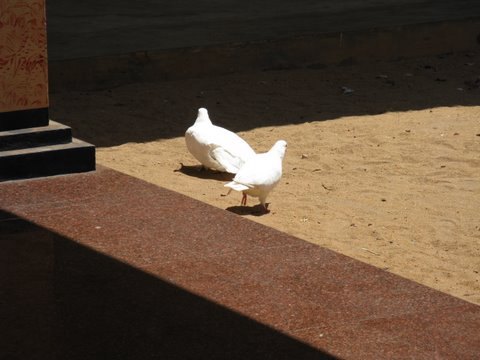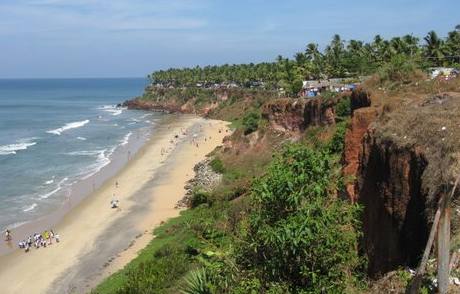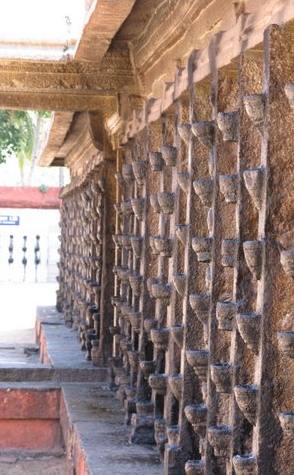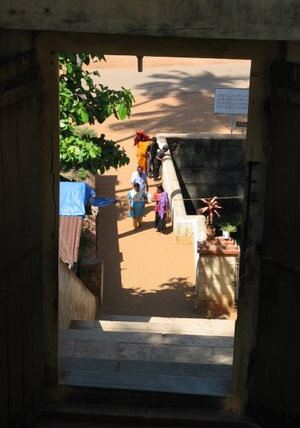LOST SOLES IN KERALA

MICHAEL J. EVANS
Michael
Evans, a former art educator, is a West Coast artist, photographer
and writer, who travels to India to find inspiration and spiritual
renewal. For more details, visit:
www.michaelevans.ca

The solar blast from
the southern Indian sun has weight, it presses down on the flesh,
forcing it to retreat in defense. Pores open, sweat leaves the
body in a steady sticky stream, sapping energy and vitality.
A walk of a kilometer or two along hot rough roads can leave
one limp and listless. Morning’s fresh garments become
soaked and stained with India’s ubiquitous red dust.
Heat from the Sun’s relentless onslaught also gets stored
in the concrete roof and walls of the small room I rent. At
night, it is slowly released and the room heats up like an oven.
There is no air conditioning. I sleep naked, spread-eagled under
the ceiling fan, set to medium, as a compromise between its
cooling power, which is deterrence to mosquitoes, and its noise,
a discordant chatter due to strained and cracked ball bearings.
In a semi daze, rivulets of sweat run from the center of my
chest to the sheet below. The hours slip by sleepless. Around
4 a.m., the room begins to cool, and sleep is near. But around
4.30 a.m. loud music from the Temple starts up. It is followed
by a Hindu priest nasally chanting out an incantation that is
being broadcast from large banks of loudspeakers that have been
set up over Varkala’s hills.
 This
strident reveille goes on to 6.30 a.m. By then, taxis and scooters
have started moving in the lanes and for most Keralans, a new
day has begun. Exhausted, sleep finally takes me into its benign
oblivion to about 8.30 a.m. Then, with heat returning, I groggily
roll out of bed, stand under a cold shower, and with a mind
that has become foggy, slowed by too many nights of interrupted
sleep, I contemplate another day.
This
strident reveille goes on to 6.30 a.m. By then, taxis and scooters
have started moving in the lanes and for most Keralans, a new
day has begun. Exhausted, sleep finally takes me into its benign
oblivion to about 8.30 a.m. Then, with heat returning, I groggily
roll out of bed, stand under a cold shower, and with a mind
that has become foggy, slowed by too many nights of interrupted
sleep, I contemplate another day.
To cope with fatigue, the wise traveler adopts a rhythm of days
to move, travel and explore, and days to chill out, relax and
catch up with chores. Today will be a wash day. I need to wash
a pile of clothes that have become heavy with sweat, salt, dust,
sun tan oil, and chai and curry stains. High humidity will slow
the drying process. Sudden gusts of wind can send the freshly
laundered clothes off the line and back onto the red dust again,
so I plan to watch over them and do some writing.
Over breakfast of Masala omelet and coffee at Silver Star Cafe,
I open my diary, now full of erasures and scribblings. I scoff
at my numerous deleted tentative itineraries, imagined journeys
and destinations, created in Canada’s temperate clime
and penciled in from reading a new crisp edition of the Lonely
Planet. Plans to do the backwaters of Kerala, tour the
spice markets of Cochin, have now given way to a plan to retreat
from Varkala’s heat and move north to Goa.
By chance, I overhear that trains are filling up fast. A Hindu
festival has drawn 1.5 to 2 million women to Trivandrum, Kerala.
They are participants of Attukal Pongola at the Attakul Bhagavathi
Temple. During the four day festival, they will camp out in
a five kilometer radius around the temple. At an auspicious
moment, a signal from a priest will start them cooking freshly
harvested rice as offerings to the Goddess Shivarti, the goddess
of learning. Surya, the Sun God and giver of all good fortune
will also be worshipped and the direction the boiling milk overflows
will be taken as an augury for the coming year.
The Festival ends on Sunday night. The next day, a mass exodus
begins and the rail system becomes plugged as it moves millions
of women back to their homes in the north.
In the midst of this migration, a “Hartal” -- a
general strike -- has been called for Tuesday. Hot headed leaders
of Kerala’s UDF party have called the one day strike to
protest the Indian Government’s modest and long overdue
hike in the prices of petrol and diesel fuel. Tuesday could
be chaotic, so I decide to forego the clothes washing ritual
and head for Varkala’s train station make a reservation.
I set
off on foot. On previous trips into Varkala, I had paid 50 rupees
or more each way for an auto rickshaw, but I hadn’t noticed
the road’s gradients. Today, after walking 1.5 kilometers
in the relative cool of the morning, I’m already soaked.
At the junction near the Janardhana Temple, I hop on a local
bus and pay 3 rupees to complete my trip to the train station.
By the time I arrive, a lengthy line up has already formed at
the reservation counter. While waiting in line, I notice a large
hand painted sign on the wall. It is a long list of 27 concessions,
conditions for claiming reductions in the cost of a ticket for
a wide variety of citizens. Looking down the list, I was surprised
to learn of my entitlements. If I could claim them all, the
Indian Government would end up paying me to ride the train!
My turn came and a rather stern looking reservation clerk looked
up from his computer. I enquired about the availability of seats
on trains going north to Goa. There was one on Thursday. The
reservation clerk pointed to a tray of forms and told me to
take one and fill it out. I found a seat and started to fill
out the small form. But I was confused, I couldn’t find
a line entry for my passport number, nor could I recall the
four digit train number the clerk had uttered. Nervously, I
rejoined the line, conscious of the fact the clerk was entitled
to refuse my form since it was incomplete.
When my turn came, I pushed it under the glass. The clerk glanced
at it and frowned, but rather benevolently, he ushered me to
the side and said quickly:
“Passport Number, do it here! Hurry; there is only one
seat left!”
I quickly entered my passport number, the train number, and
ticked a box for a second class sleeper and another box requesting
a senior’s concession. After attending to a few more customers,
he waved me back to the window, glanced at my form and begun
typing data into his computer. A few moments passed, and then
he suddenly looked up from under his spectacles.
“That will be 254 rupees!” he said.
Incredulous, I realized that I had both my ticket and my 30%
seniors discount and that on Thursday morning I was going to
travel over 1000 kilometers, nearly 60 % the length of the Indian
sub-continent for just $7.50 Canadian! The combined flights
down the east coast of India from Bhubaneswar to Trivandrum
had cost me 8,000 rupees or $200.00 Canadian!
Awed, I pondered the benevolence of a system that could move
millions of pilgrims all over India so efficiently and cheaply,
but also made it as affordable as possible by granting so many
concessions for reduced fares. I was awed again, when a few
weeks later; the Indian Government announced it was cutting
rail fares by a further 5-7 %. Indian Railways runs more than
14,000 trains a day, carrying a total of over 18 million passengers.
I also contemplated how the quality of engineering built into
the rail system during the British Raj might benefit India in
the future. Europe was already introducing TGV express trains
capable of traveling at over 350 kms/hr. connecting major cities
on its rail system. In the post oil era, India is well placed
to move towards this green and efficient form of mass transit.
India’s rail system was engineered to high standards capable
of supporting fast passenger express trains. Major cities are
linked by Rajdhani and Sahatabdi express trains. This is in
contrast to the United States, where the rail system was engineered
for slower freight trains rather than fast passenger expresses.
The extensive interstate highway system was developed when oil
was abundant and cheap. India’s road system is not so
well developed. As the world price of oil escalates, India could
back away from investing in expensive highways and instead use
its resources to follow Europe’s lead and develop a high
speed rail system for the 21st century using its abundant hydro
electric power.
I needed cash, so I took the bus back to the Bank of South India
in Varkala. But the “check girl” was away sick that
day. So I continued on foot back to the Bureau of Exchange at
the junction near the Janardhana Temple and the ancient village
tank -- a distance of about one kilometer.
 I
arrived hot and dusty and needed a refreshing cup of chai, so
I wandered over to a small hotel that had a shaded verandah
overlooking the ghats, the steps used for bathing and worship,
that led down to the village's reservoir of fresh water. The
square reservoir, which in India is often referred to as a tank,
was about the size of two Olympic swimming pools . At water's
edge on the ghats, a group of local Hindus were taking their
daily bath and washing their clothes. Nearby, close to an ornate
stone fountain, a group of young boys were having great fun
testing each others mettle by doing back flips into the reservoir's
cool waters.
I
arrived hot and dusty and needed a refreshing cup of chai, so
I wandered over to a small hotel that had a shaded verandah
overlooking the ghats, the steps used for bathing and worship,
that led down to the village's reservoir of fresh water. The
square reservoir, which in India is often referred to as a tank,
was about the size of two Olympic swimming pools . At water's
edge on the ghats, a group of local Hindus were taking their
daily bath and washing their clothes. Nearby, close to an ornate
stone fountain, a group of young boys were having great fun
testing each others mettle by doing back flips into the reservoir's
cool waters.
This peaceful scene was soon shattered by a volley of ear spitting
explosions from shells scaring crows away from the Janardhana
Temple opposite the tank. I downed my chai and left. After cashing
my check, all seemed quiet, so I decided to visit the Temple.
It was originally built as a shrine to the god Vishnu over 2000
years ago. The Temple was rebuilt in the 12th century and has
been an important pilgrimage center ever since.
I walked up to the shoe stall, took off my sandals and their
expensive Velcroed-in orthodics, and passed them over to the
wizened old shoe lady. She gave me ticket # 456. Not intending
to use my camera, I stashed it deep in my bag I climbed up the
long flight of stone stairs. Half way up, I stopped and paid
the 25 rupees entrance fee, but declined to pay an additional
100 rupees for cameras and photography.
Once in the Temple grounds, I walked around, but the stone and
sand paths were too hot for my untempered feet, so I sought
out narrow bands of shade that ran along the side of the Temple
and gingerly moved along them. Finally, feet burning, I decided
to find refuge from the sun in the outer sanctum.
 At the entrance, I paused at two large, brightly colored statues
of Garuda, an important lesser god in Hindu mythology. At his
feet can be seen the serpent he slew in order to create a life
sustaining elixir. Worship of Garuda is said to help eliminate
poisons from the body. Eliminating poisons from the body is
a central concept in Ayurvedic medicine called “panchakarma”
meaning the five actions needed to cleanse and rejuvenate the
body. Also in the temple is a shrine to Hanuman, an important
figure in the Ramayana. He is often depicted carrying
a mountain. When Lord Rama’s son Lakshama was seriously
wounded in battle, Hanuman was sent to fetch Sanjivani,
a life sustaining herb from Pronagiri Mountain in the Himalayas.
When he couldn’t find the specific herb before nightfall,
he displayed his incredible strength and lifted the entire mountain
up and took it to the battle field so many helpers could help
locate the herb. The herb was found and Lakshama was saved.
At the entrance, I paused at two large, brightly colored statues
of Garuda, an important lesser god in Hindu mythology. At his
feet can be seen the serpent he slew in order to create a life
sustaining elixir. Worship of Garuda is said to help eliminate
poisons from the body. Eliminating poisons from the body is
a central concept in Ayurvedic medicine called “panchakarma”
meaning the five actions needed to cleanse and rejuvenate the
body. Also in the temple is a shrine to Hanuman, an important
figure in the Ramayana. He is often depicted carrying
a mountain. When Lord Rama’s son Lakshama was seriously
wounded in battle, Hanuman was sent to fetch Sanjivani,
a life sustaining herb from Pronagiri Mountain in the Himalayas.
When he couldn’t find the specific herb before nightfall,
he displayed his incredible strength and lifted the entire mountain
up and took it to the battle field so many helpers could help
locate the herb. The herb was found and Lakshama was saved.
Another myth describes how Varkala and its main beach, Papanasam,
got their names. In the Ramayana, Narada was a traveling
monk who was approached by a group of mendicants who confessed
to sinning. Narada was wearing a cloak made from bark fiber
called a Vakkulum. He threw his cloak into the air,
the place where it landed became known as Varkala. Narada told
the mendicants they were to pray there in a place by the seashore.
That beach became known as Papanasham, meaning “Redemption
of Sins.” At the far end of Papanasham Beach, mineral
springs gush out of the bottom of the cliff that encloses the
beach. They are reputed to have medicinal qualities that are
said to cleanse. It is no accident that Varkala has evolved
into an important center for Ayurvedic medicine.
As my eyes adjusted to the dark of the outer sanctum, I stood
respectfully still, admiring the statues of the deities. Suddenly,
a priest walked by me gesturing and loudly ushering out two
female tourists whose movement or demeanor had clearly offended
him. I stayed absolutely still, intent on honoring the gods.
He ignored me. After he passed, I took a long glance into the
inner sanctum, a sacred area only accessible to Hindus. It was
dark and mysterious, with walls blackened with soot from years
of incense burning and votive offerings. Peering in, I could
vaguely see the shrine to Vishnu in its dim recess.
On my way out, I paused for my eyes to adjust to the bright
light. By the exit, I was drawn to a large curious looking Banyan
Tree. The top was festooned with dried coconuts and the bottom
was strewn with hundreds of cheap plastic dolls that had long
since lost any coverings. I was curious about what these offerings
meant and thought to look it up later. I surreptitiously took
out my camera and took a quick shot.
Suddenly, a voice behind me yelled out. A rather stout young
man wearing brown slacks and freshly ironed shirt, rushed up.
“Camera, you pay 100 rupees. See ticket? He demanded.
“No ticket!” I exclaimed. Embarrassed, I quickly
produced a 100 rupee bill.
“Sorry, I meant no disrespect. I just took one, a photo
of the tree. I was curious!” The man took my 100 rupee
bill and stuffed it in his shirt pocket.
“Okay for me now to take photos of the Temple? I asked.
“Yes, OK!” he replied.
Deciding to get my money’s worth, I settled into an hour
or so of photography. Relaxing, I took images of white peace
doves, brass Ganeshes, and the outer walls of the inner sanctum
that were blackened and textured by innumerable incense holders.
When my batteries ran out I went over to the Kuttambalam, a
long open colonnaded structure, and sat under its shade to replace
them. A young couple came by and we started to chat. They were
from Montreal, an editor of an arts magazine and his wife; we
found lots to talk about. After an hour or so, I bade farewell
and headed to the top of the exit stairs.
The Temple had become eerily quiet; there were no priests or
other tourists about. I carefully eased my way down the hot
steps. At the bottom, I walked over to the shoe stall. It was
empty, the shoe lady had gone! I went behind the counter; the
rows of shelves were empty. My sandals and their expensive orthodics
were also gone! A bolt of anxiety and fear flashed through my
body! Damn it! I would have to make it back on hot pavement
without sandals. My feet were already scorched.
Looking right, I could see a few auto rickshaws lined up in
the junction of the road that went over the cliff back to Varkala
beach. I could take one, save my feet and accept the loss of
my sandals. I looked left, the road ran straight. The left hand
side was shaded, once down by the beach, I could walk on wetted
sand and work my way back with minimum damage to my feet. I
took my chances in the shade and turned left.
 After
about fifty meters, I saw a long low shed to the right. I noticed
a beggar lady sitting quietly in the shade. I looked more closely;
there was something by her side. I quickened my pace, and recognized
the flash of blue from my orthodic’s liner. She had my
sandals! I crossed over, smiling broadly.
After
about fifty meters, I saw a long low shed to the right. I noticed
a beggar lady sitting quietly in the shade. I looked more closely;
there was something by her side. I quickened my pace, and recognized
the flash of blue from my orthodic’s liner. She had my
sandals! I crossed over, smiling broadly.
“You have my sandals! Thank you so much !” I passed
over my ticket and paid her 30 rupees. I could have hugged her.
Sandals on, I proceeded down the road feeling elated and grateful
for the sudden reversal of fortune. Getting hot, I decided to
enter a Kashmiri jeweler’s shop, ostensibly look at rings,
but also to cool down. As I sat down to peruse a tray of rings,
the door opened and a fresh faced young English girl popped
her head in.
“Do you have any scarves? I need one, I’m visiting
the Temple!” she asked. The owner pointed to a shelf of
cheap polyester scarves. “Over there, 100 rupees!”
he said.
While she was making her selection, I told her about my visit
to the Temple and the encounter at the shoe stall. She listened
with interest, smiled and said.
“Just before I left for India, a good friend of mine told
me that when you go to India, you have to take a little bit
of trust with you!”
How true! That afternoon, my attachment to India, its people
and its culture, deepened.
Photos
© Michael J. Evans
Related
Article
Bad
Belly in Delhi